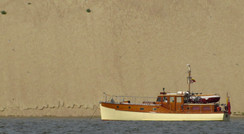Baltics & Poland
- leevfisher
- May 2
- 2 min read

Early one summer Ruda left her winter berth in Kotka and crossed the Gulf of Finland to Estonia and its capital, Tallinn. In this city of perfect medieval streets and turrets the crew celebrated a rain-lashed midsummer in the main square of the lovely Old Town.
From Estonia, Ruda went south along a rock-strewn coast of glacial erratic boulders to Latvia, pausing awhile at Salacgrīvas for her crew to kayak the rapids of the Salaca River past the famous red sandstone cliffs and extraordinary lamprey weirs.
From Salacgrīvas she continued south to cross the Gulf of Riga on her way to her 7th European capital; Riga, Latvia’s gorgeous Art Nouveau principal city. Here she rested in a basin at the end of the old moat of the former fortifications, which now forms a canal through the heart of the city while the crew kayaked the Daugava River to enjoy views of Riga’s spires and the Vanšu cable bridge.
Ruda’s arrival in Lithuania was greeted by 72 knots of hurricane force winds which caused havoc in that country’s main port, Klaipeda. Emerging unscathed from that calamitous introduction, she hurried away into the calm of the Curonian Lagoon, a brackish 95km stretch of water separated from the Baltic Sea by a spit of land composed entirely of shifting sand dunes.
The Curonian Lagoon is partly in Lithuania and partly in Russian Kaliningrad, so Ruda motored as far south as the little holiday town of Nida on the Lithuanian side of the border where she encountered a cheerful little fleet of Kurenkahns, traditional shallow draft Curonian Lagoon boats with their characteristic weather vanes.
After some very pleasant days spent enjoying sun (and the plentiful sand) she headed out into the Baltic to begin a long overnight passage around Russian Kaliningrad, and its live firing exclusion zone, towards her next destination: the Polish town of Hel. After spending some time in Hel, Ruda passed along the Westerplatte peninsula, dipping her ensign to the memorial that marks the site of the first action of the Second World War, before motoring up the Martwa Wisła to Gdańsk.
Finding a very good mooring in Gdańsk with a view of the famous waterfront and its C15th dock crane, the crew enjoyed exploring the reconstructed town centre and the colourful Long Market, crowded and lively for the annual St Dominic’s Fair.
Viewed from the brackish waters of the Baltic, the Polish coast south of Gdańsk seems to be mile after mile of continuous golden beach. Its resort towns may have as many touristic pirate ships as they have fishing boats, but they can’t be faulted for their exuberant holiday atmosphere. When Ruda had her fill of partying she continued south to Germany.













































